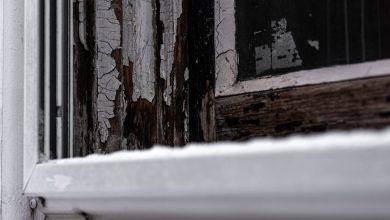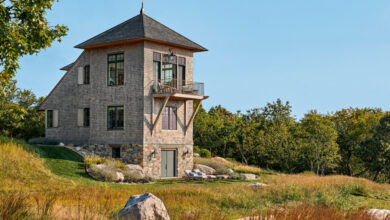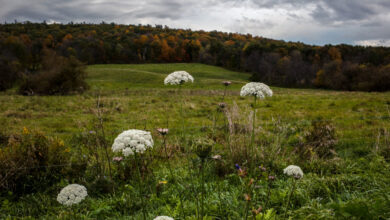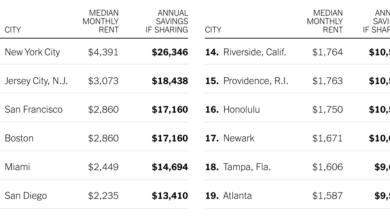A Cherished Family Home Gets a Second Act
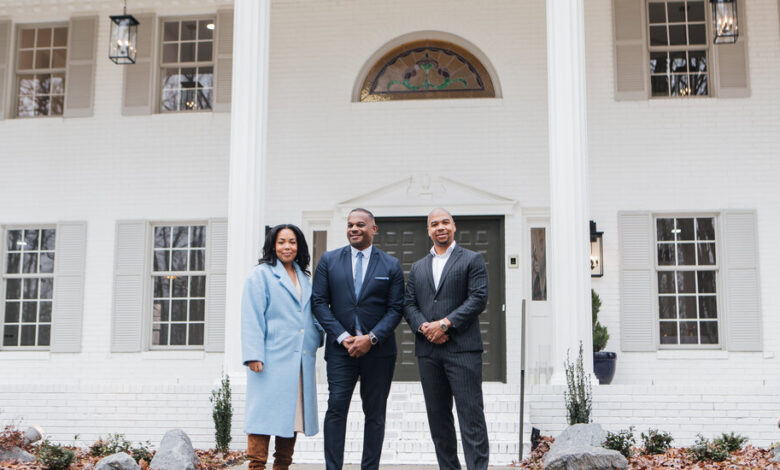
For many years, a thought often crept into Michael Newell’s mind: “What if I bought my childhood home?” He wanted to keep the cherished house, but give it another purpose. Sometimes he shared that thought with his then-girlfriend, Marché Robinson. But it never went further than that.
That childhood home — a 7,000-square-foot colonial-style house located on a 16-acre lot just south of Greensboro, N.C. — was built by Mr. Newell’s parents in the early 1980s, and Mr. Newell has only the fondest memories of growing up there with his parents and five older siblings. The home was filled with joy, happiness and love, he said.
“Whether it was full of family members — even when it was just me and my mom and my dad — we always had a good time in the house,” he said.
Mr. Newell and Ms. Robinson got engaged in 2018, and when they started searching for a place to get married, Mr. Newell, 38, a lawyer and a restaurateur, started thinking about the family home once again. But with his career on the rise, and without quite knowing the logistics of converting a family home into a commercial wedding venue, he left the idea alone. It wasn’t until after he and Ms. Robinson got married in 2019, at a historic home that was being used for weddings, that he decided to make his own dream come true.
“Our venue kind of inspired him to bring it up again,” said Ms. Robinson, 37, a lawyer and lifestyle influencer.
Buying the house and breathing new life into it would keep it in the family, Mr. Newell figured, and it would also give the family another revenue stream. In addition, he had become aware of how little diversity there was in the wedding business.
“The landscape of the wedding industry is kind of monolithic,” Mr. Newell said. “There’s not many Black people that own venues. I don’t personally know any and I had that moment of ‘Why not us? Why not this place? Why shouldn’t we?’”
The wedding business is a $100 billion industry in the United States, and couples spend the majority of their budget on venues, according to The Knot, a company that tracks wedding trends and has an online marketplace that helps people plan weddings.
The Knot’s 2021 Real Weddings Study found that couples spent a national average of $10,700 on a venue. In North Carolina, couples spent an average of $23,000 on the ceremony and venue combined.
The Newell House opened in November and has, so far, been used for private events like birthday parties. The Newells have started receiving bookings for 2023 weddings.
Room for Six to Roam
In the 1970s, when Dottie Newell and Dr. McArthur Newell, her husband, imagined their dream home, they envisioned a spacious kitchen, dining and living room, many bedrooms for their children, a huge yard and plenty of space to entertain. It only made sense that when they found the land on Lancelot Drive in Pleasant Garden, N.C., they decided to build their dream home there.
“We liked that it was on 16 acres,” Mrs. Newell said. “I liked the freedom of my children being able to run around the neighborhood and explore and have little paths that they could go on. We saw animals and we had friends come over. It gave us space we felt would allow us to do the fun things we liked doing.”
The Newells moved into the house in September 1983. Four months later, their youngest child, Michael, was born.
Mr. Newell said that his parents succeeded in creating the home they dreamed of. The Newell home was the hub of entertainment, gatherings and a constant feeling of community. He recalled having friends stay at the house for sleepovers, exploring the backyard (there’s a creek if you walk far enough back), waking up and cleaning on Saturday mornings (his mother is skeptical of just how much cleaning he did as a boy), dancing around the house as music played through the record player that was built into the kitchen wall.
The Newells often played Nina Simone and B.B. King. Sometimes they played classical music. Other times they played jazz. James Brown — one of Dr. Newell’s favorite musicians — was a fixture. Dinner parties, birthdays, anniversaries, homecomings and more were hosted at the home, and frequently, Mrs. Newell changed the doorbell chimes to match the occasion or time of year.
When Dr. Newell died in July 2002, long after five of the children had grown up and left home, and just a month before Mr. Newell left for college, selling the house wasn’t a consideration. There were too many good memories there.
“This house is a magnet for me,” Mrs. Newell said. “It was such a labor of love. When we were there, and our neighbors who were friends, college friends and high school friends were there, it was just a joy. I loved that and I wanted it to continue.”
In August of 2002, Mr. Newell left home to attend the University of North Carolina at Chapel Hill, and he frequently brought his friends home to visit. Other family members also came to visit, but as the years went on it became clearer that there was too much house for one person. The Newell family talked occasionally about selling the home, but Mrs. Newell could not imagine not keeping it in the family.
“In some ways the logical thing would have been to sell the house, but I think for us and for my mom, too, it didn’t feel right to do that,” Mr. Newell said. “It just felt a little bit hard to imagine what it would have felt like to lose it.”
Mrs. Newell added: “You know, that song ‘There’s a sweet, sweet spirit in this place?’ That house has that.”
Keeping the Spirit Alive
When Mr. Newell and Ms. Robinson began to seriously consider buying the house in late 2019, they knew that keeping the spirit of the home alive would have to be at the heart of the project. But how could they update a family home from the early 1980s and keep what made it special, while also making it appealing to a diverse array of couples who might want to get married there?
They enlisted the guidance of Howard Eason, who is married to Mr. Newell’s sister, Donna. Mr. Eason, an interior designer who has worked as a handyman (he was a contestant on HGTV’s “All American Handyman”), said that he remembers walking through the house for the first time.
“They needed someone to come in, just look at it and say, is this something that we should do or not do?” Mr. Eason said. “Of course, seeing that the foundation and the bones were superb, I told them that we should move forward with it.”
They bought the house from Mr. Newell’s mother, who had moved out in 2015, but kept her belongings there until the renovation was underway. Updating a four-decade-old house, while maintaining its character, might have been a daunting possibility for some people, but Mr. Newell had the perfect partners in Ms. Robinson, who loves a challenge, and Mr. Eason, who also knows plumbing, construction and design.
“My strength as well as my flaw is that I really don’t hear an idea and think we can’t do it, so I was like ‘It’s been done before so we can do it.’” Ms. Robinson said.
For the next three years, Mr. Eason oversaw the replacement of plumbing and drainage systems, tearing down walls and replacing flooring. The original brick on the outside of the house was painted a pristine white to make it pop and “to give it some visual interest,” Mr. Eason said, adding that much of the interior work was cosmetic, like redoing the drywall. The floors were redone with walnut and the walls were painted in mostly neutral colors to appeal to a wide range of couples getting married. New trim was added to the walls — “even if it’s kind of whitewashed in spots, you will see details, texture and contrast,” Mr. Eason said.
Mr. Newell said he spent $300,000 on the renovation, and compared the earliest days of the renovation to an old car that hadn’t been used in a long time, with broken parts, rusty spots and in need of a lot of love. He said there were certain elements that needed to be incorporated into the renovated house.
On the list of things to keep: the record player in the wall, the doorbell, the trees and plants that Mr. Newell’s parents had received as gifts when they first moved into the home.
“There are definitely little ways we’re trying to keep tradition in the house,” Ms. Robinson said.
Planning for the Future
While buying the house was an emotional decision, driven by a desire to keep a home filled with memories in the family, it was also a practical business decision, Mr. Newell and Ms. Robinson said. Ms. Robinson’s father had his own businesses and she inherited his entrepreneurial spirit. Mr. Newell has his own restaurants and law firm, and was always thinking of what to do next.
“It’s always been in his mind that we should build, build, build opportunities, so if we have children they can be able to have a job already there for them if they choose to pursue it,” including nephews and nieces, Ms. Robinson said.
Ms. Robinson and Mr. Newell know that their experience isn’t a typical one, particularly for Black families who may not have a house, let alone multiple properties, to turn one into a business, but they know that their experience has the potential to inspire those who are in a similar position, or would like to be.
With more than 140,000 Instagram followers on her personal Instagram page and 15,000 on a page she created for the house itself, Ms. Robinson regularly gets messages from Black people who have recently inherited a home, but who don’t know what to do with it. Many don’t want to keep the home because it is in a place where they don’t live.
“Even if they don’t live in it, maybe they can make it an Airbnb, maybe they can make it a venue, just keep that property in the family,” Ms. Robinson said. “We found a way to keep the house in the family without making it be someone’s burden to live in it.”
For weekly email updates on residential real estate news, sign up here.



